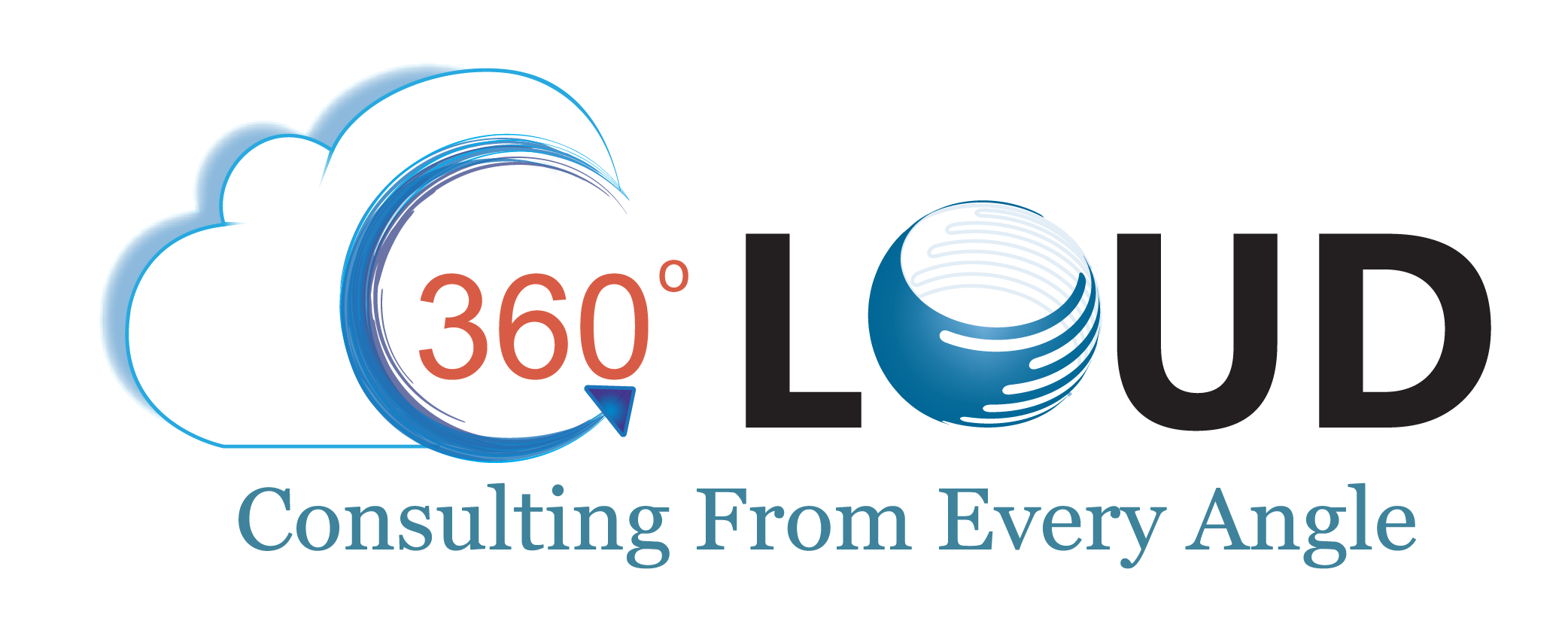The most legendary teams can be great individually, but together they are magnificent. The same goes for Salesforce and email clients. There are perhaps, no two systems more critical to business, so bringing them together makes sense.
For teams that pretty much ‘live’ in the inbox (like sales) integration of Gmail and Outlook to Salesforce immediately creates efficiency and reliability by eliminating the need for navigation back to the CRM to store details. And that’s just what we’re about to show you.
This also has increasing returns when you combine email campaigns and tracking.
Bringing together the power of two applications through integration can make any business an unstoppable revenue-generating machine.
We’ve been helping our clients solve integration challenges of any complexity and implement Salesforce email integrations to increase efficiency.
Email is one thing every business professional checks when starting the day. And not just in the beginning of the day, emails are to be checked in every now and then. For a user working on Salesforce, it can certainly be tricky to keep switching between the CRM and inbox just to send an email or to keep a track of replies. That’s where the need is to connect both these platforms.
So, let’s talk about collaborating our inboxes (Gmail/Outlook) with Salesforce.
Create and Send Emails Directly from Salesforce
If you are a growing business, you would see the technology stack broadening each day. This would make it confusing for your team to constantly jump between the growing list of your sales and marketing strategies. But from experience, once you implement this, there’s no turning back. Your teams will take inbox integration for granted and wonder how they ever got on without it.
Integrating Salesforce with your email will streamline the process and will allow you to execute your email strategy without the need to leave the Salesforce instance. Thus, integrating your Salesforce with emails means that you can spend more time being analytical and creative and less time struggling with menial tasks like data entry.
Now, let’s cover the steps to integrate Outlook and Gmail with Salesforce.
How to Integrate Outlook with Salesforce
Carry out Salesforce Outlook integration with the steps given below:
Step 1: Select Outlook in Salesforce
Log in to your Salesforce account. In the Setup section, type Outlook in the quick find box and select the Outlook Integration and Sync option. Click Outlook Integration and Lightning Sync to enable it.
Then you have to activate Outlook’s Enhanced Email feature. Select Active and Notify Reps and toggle the Active and Advanced Email Security Settings checkboxes to true. Click Save.
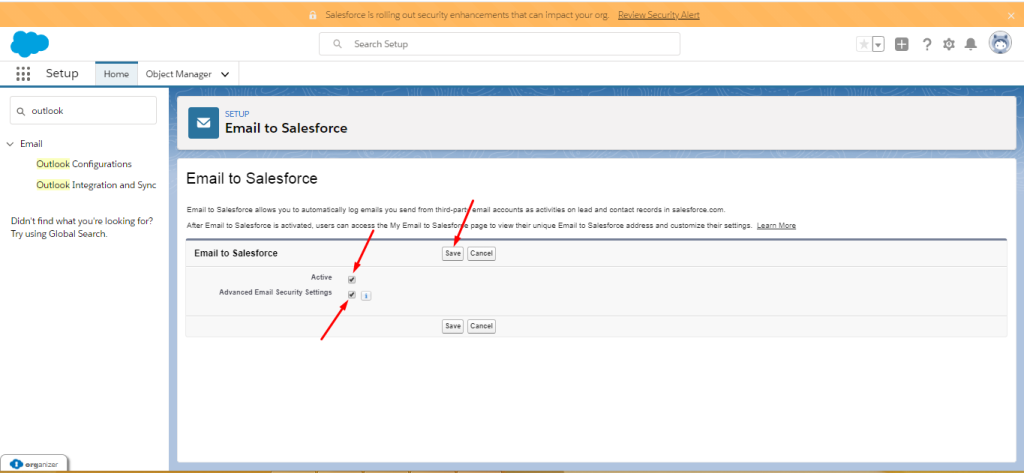
Step 2: Configure Outlook
In the Fast Find Box, type Outlook and click on Outlook Configuration. Type the desired Name and click the Active checkbox to true.
Under the Assign users and profiles section, select Users and users to whom you want to grant the Outlook sync permission.
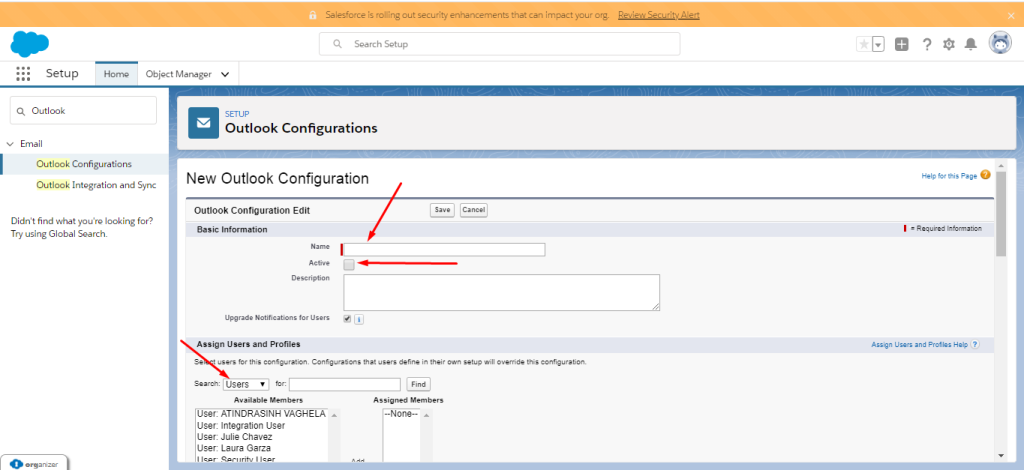
Under the Assign Users and Profiles, select Profile, and select the profile to which you wish to provide Outlook sync permission.
Select the Set Default Sync setting to synchronize All Outlook Items in the Data Settings. Click Allow users to select the attachments option according to your need.
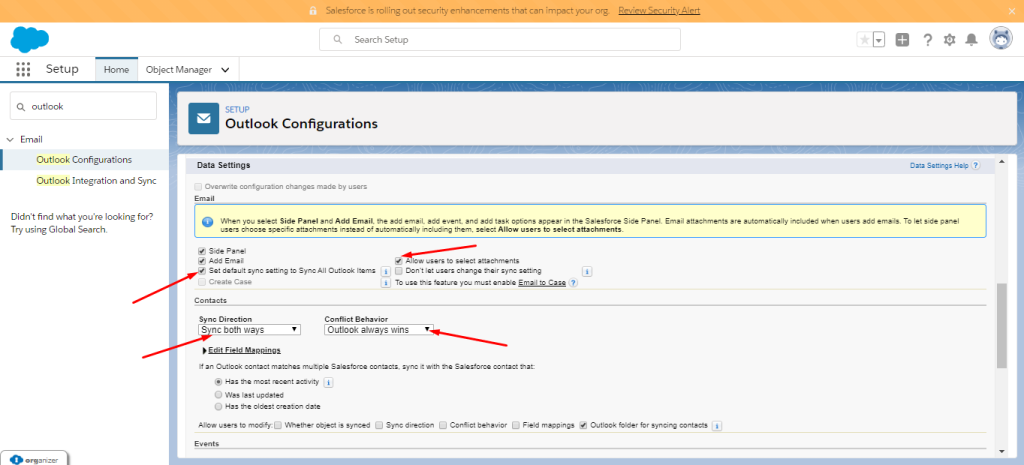
Choose Sync Both Ways and conflict in Contacts Sync Direction. Make changes as desired. Follow the step given above for Events and Tasks. Click Save.
Click Enable. Add opportunity split list to the required opportunity page layouts and click Save.
Step 3: Configure Salesforce
Select My Settings from the drop-down menu beside the Setup. Now. add User Name. In the quick find box, type Outlook and select Salesforce for Outlook.
Scroll down and click Download (Version). Run the Setup File.
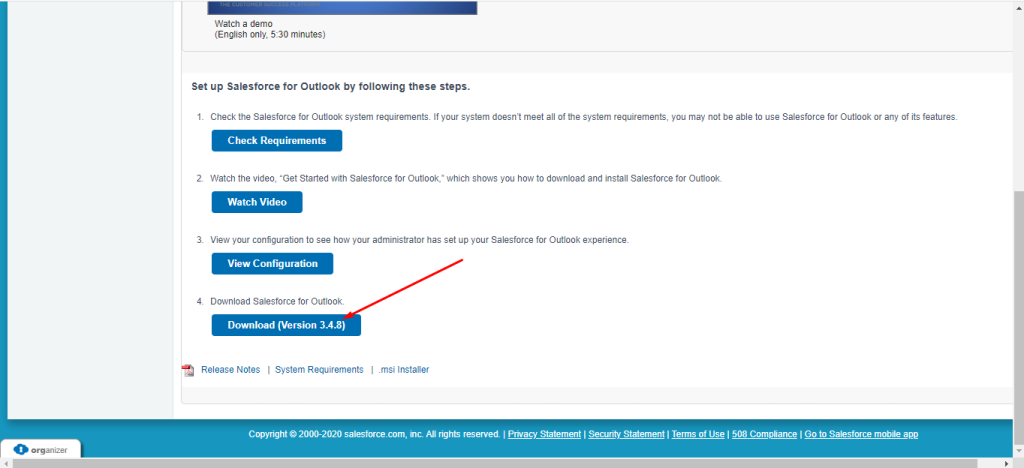
Step 4: Integrate Salesforce and Outlook
After installing Salesforce for Outlook, launch Microsoft Outlook. Use Microsoft Outlook to sync your email address
Select “Settings”. You have to log in with your username and password. Select “Sync Only the Outlook Items I Select”. Choose the default option and click Next.

Click Save. The Salesforce Outlook Integration is successful.

You can also download a PDF version of the
steps to integrate Outlook with Salesforce.→
Salesforce Outlook Integration Use Cases
1. Access Salesforce Features in Outlook
You can easily search for Salesforce records with custom objects and create Salesforce records based on standard objects such as contacts, cases along with custom objects. You can also connect email messages and calendar events to Salesforce contacts and records accepting email messages or tasks.
2. Add to Activity Timeline Automatically
You can add the sent and received emails to the activity timeline with Einstein Activity Capture pertaining to the contacts, opportunities, leads, and quote records.
3. Sync Contacts and Events
The integration enables you to synchronize events in a series. Sales representatives can get updated contacts and scheduling data when required.
You can do a lot more while using Outlook within Salesforce. Here are more features you can use with Outlook and Salesforce integration.
1. Access Salesforce Tasks
You can access your Salesforce tasks within Outlook and mark them as ‘in progress’ or ‘complete’ just as you would when working with the task in Salesforce.
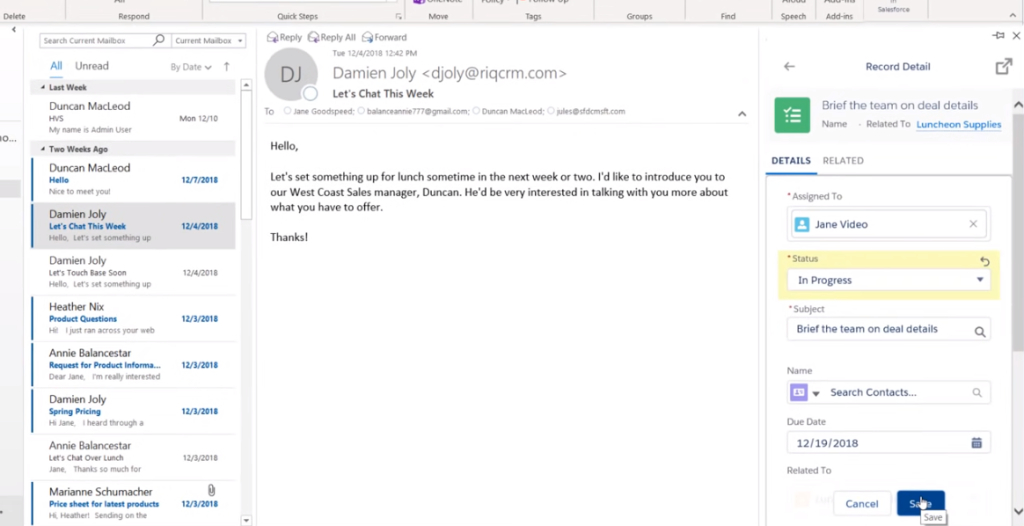
2. Add Records
You can add new records to capture new Opportunities, Leads, Tasks, and any other object defined by the Salesforce admin without leaving Outlook.
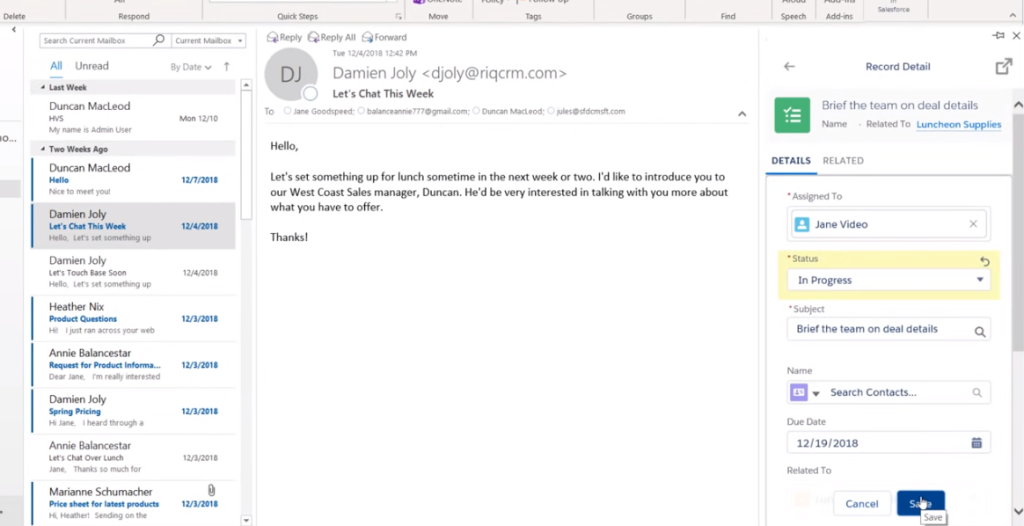
3. Use Templates
You can use templates to compose emails faster and with consistent messaging. You can use Quick Find to locate the template.
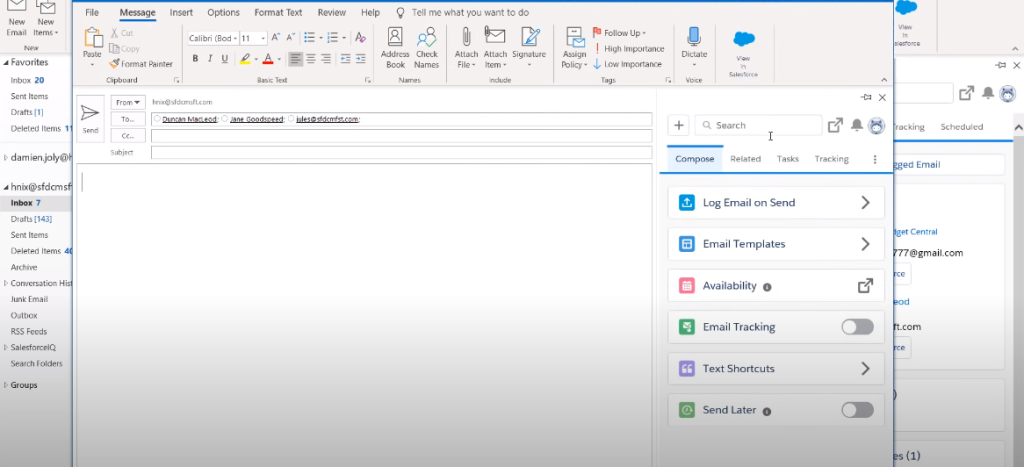
4. Access the Added Productivity Features
You can track your emails as in when it is read so you know when you can follow up. You can also track the links you include in an email to know which links people click.
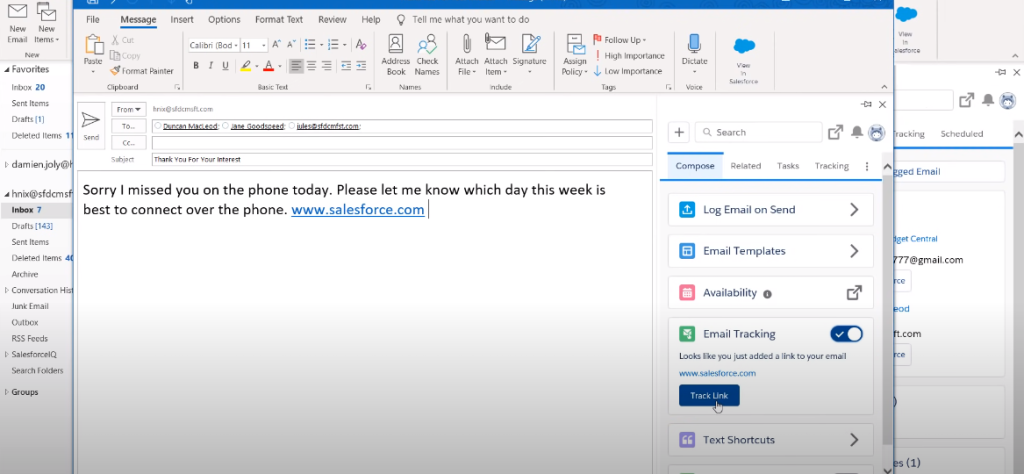
You can write your emails when it’s convenient and have them sent later when they will have the biggest impact.
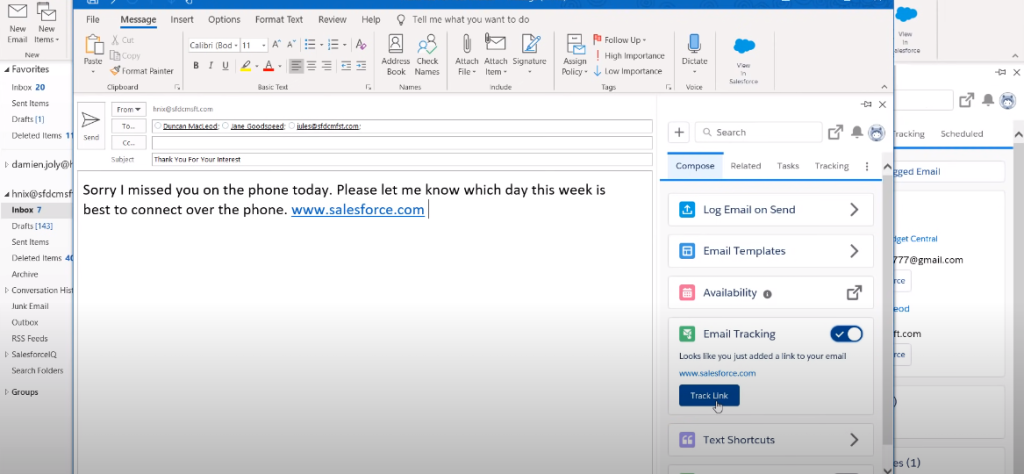
5. Set Availability
Say goodbye to those back and forth emails to schedule meetings. You can set your availability to select open time slots from your calendar and insert them in an email
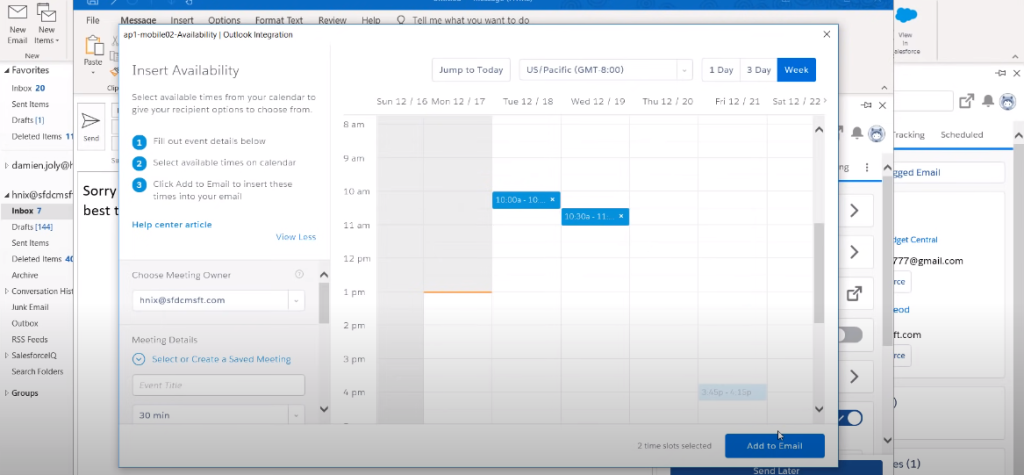
How to Integrate Gmail with Salesforce
You can integrate Gmail with Salesforce just by following a few steps mentioned below:
Step 1: Log into your Salesforce Account
Log in to your Salesforce Lightning Account and navigate to the Setup Icon.
Step 2: Configure Salesforce Gmail Integration
In the Setup section, type Lightning for Gmail in the quick find box and press Enter. Select the Lightning for Gmail and Sync option.

Configure one or both products from the Lightning for Gmail and Sync options according to your needs.

Step 3: Perform Optional Customizations
Ensure that Lightning Sync and Use Enable Enhanced Email with Gmail options are turned to get the best out of this integration. These options will help to log emails as standard message objects and will activate emails to Salesforce. Representatives can easily add events and attachments. You can even access Einstein Activity Capture to add emails and events to the activity timeline of Salesforce.
Step 4: Customizing Content
The integration is now complete. Your sales staff has to customize the content using Lightning App Builder after the integration process.
Here’s another PDF instructable of the
steps to integrate Gmail and Salesforce.
Salesforce Gmail Integration Use Cases
You can send emails to a group of prospective clients and add everyone in the thread to Salesforce. Select all the participants and click “Add to Salesforce”. You can even use the New Contact button to add the participants directly to Salesforce.
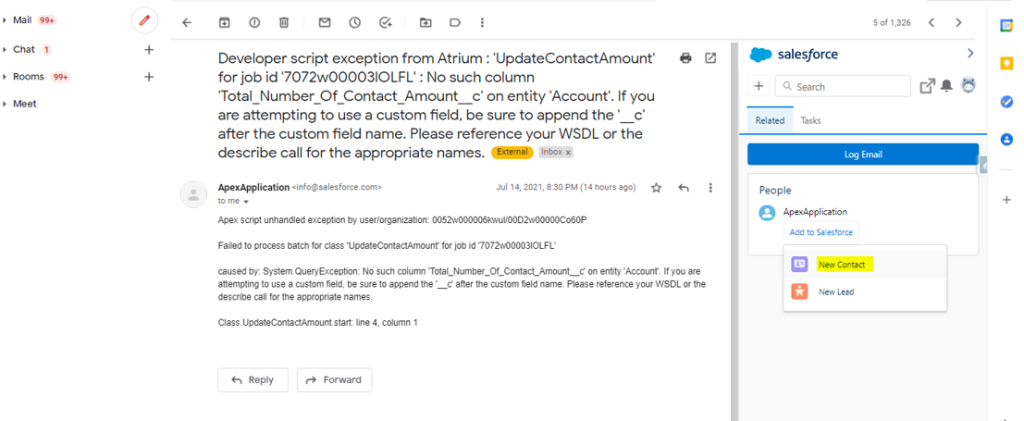
You need to make sure that records are properly imported. Create a Global Action in Salesforce to do so.

Once you save it, you’ll see a screen for selecting the fields for the page layout. You’ll see it after selecting the New Contact action in the Gmail Salesforce extension.
Add the action to the publisher layout so it stays visible on the main screen. Enter “Gmail Integration and Sync” in the Quick Find box. Go to the email application publisher and edit it.

After you drag and drop the global action to the global publisher layout, you’ll see the New Contact button. When you click New Contact, you’ll see the following window to fill in extra details. Here, “Apex Application” is being added as a new contact.
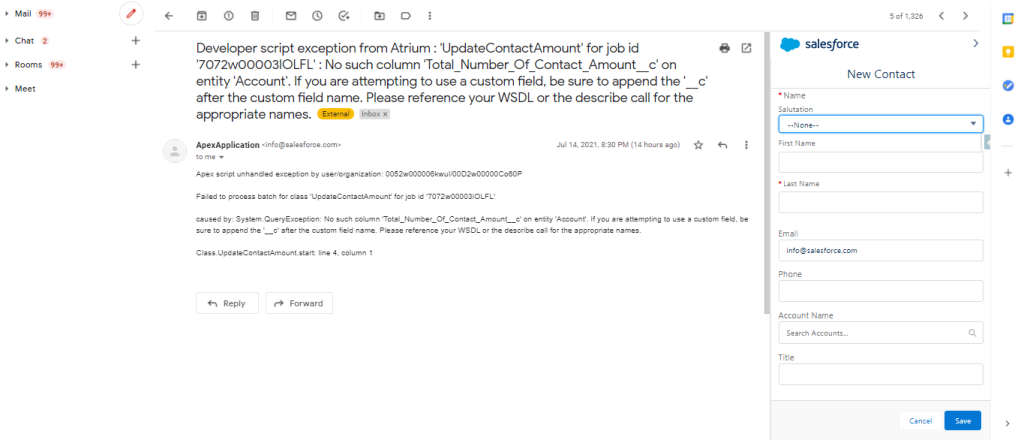
After filling in the details and refreshing it, you’ll see this as a contact in each email thread it’s in.
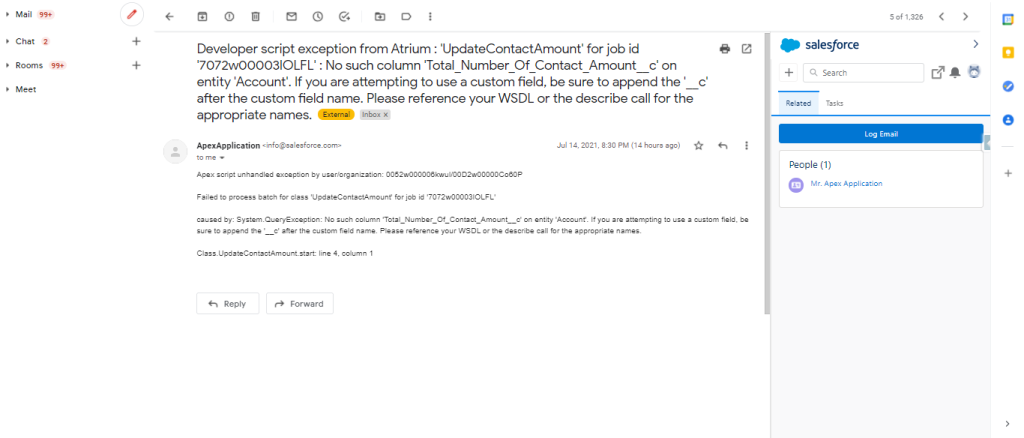
There’s still a lot more you can do while using Gmail within Salesforce. Here are more features you can use with Gmail and Salesforce integration.
1. Add Records
You can add new records to capture new Opportunities, Leads, Tasks, and any other object defined by the Salesforce admin without leaving Gmail.
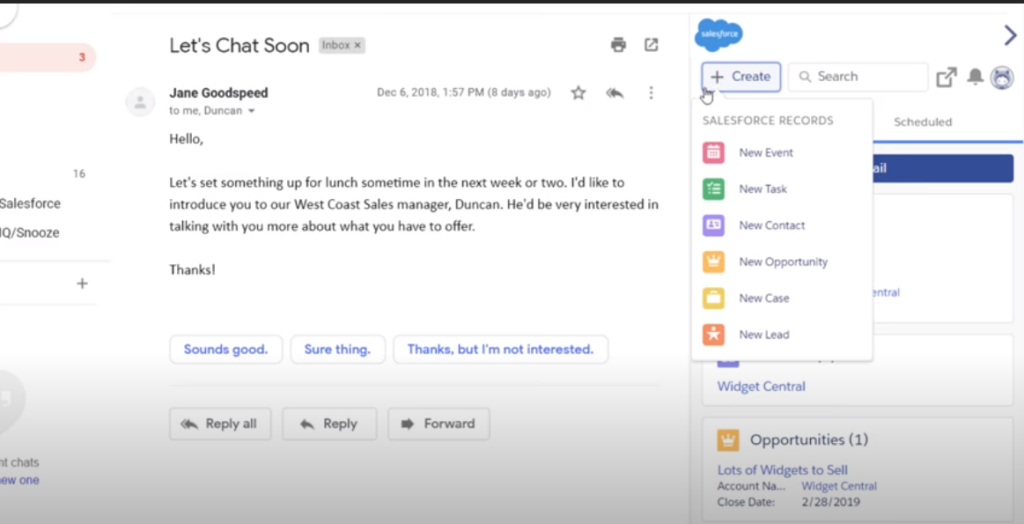
2. Search Users
Search Salesforce to find people to log the email to. The email is logged to the Salesforce record in Salesforce.
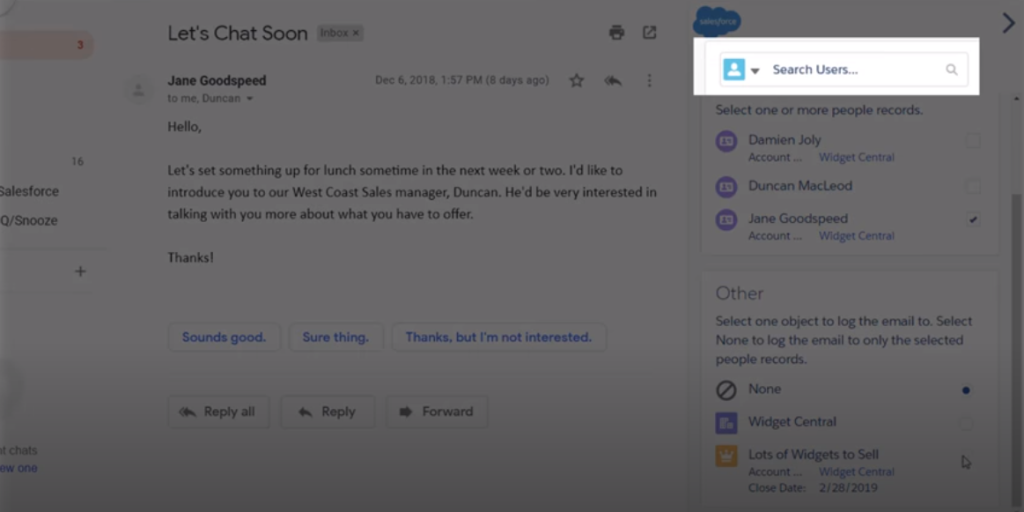
3. Use Templates
You can use templates to compose emails faster and with consistent messaging. You can use Quick Find to locate the template.
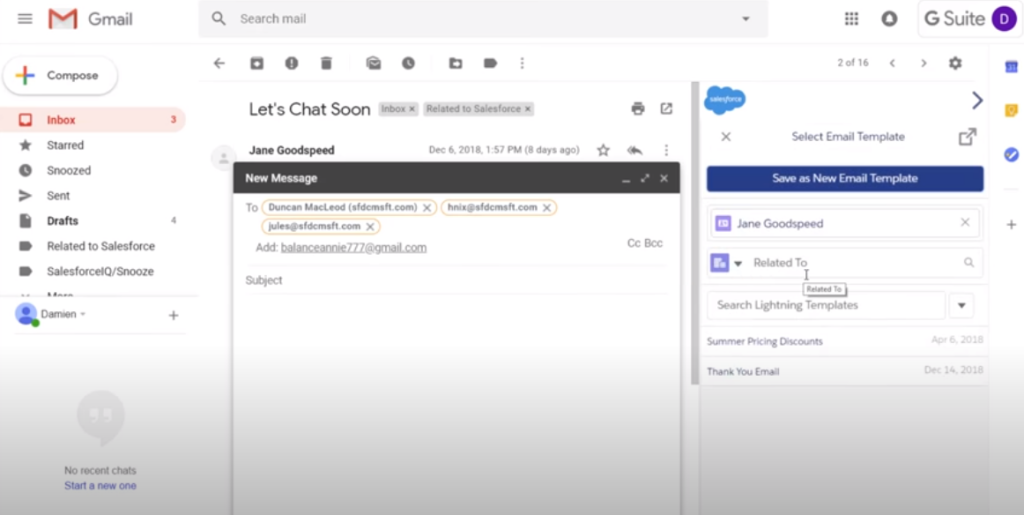
4. Access the Added Productivity Features
The integration provides you with many added productivity features so you can do more when you compose emails. You can save phrases you use the most, so you can add them quickly and consistently to your emails. You can track your emails as in when it is read so you know when you can follow up.
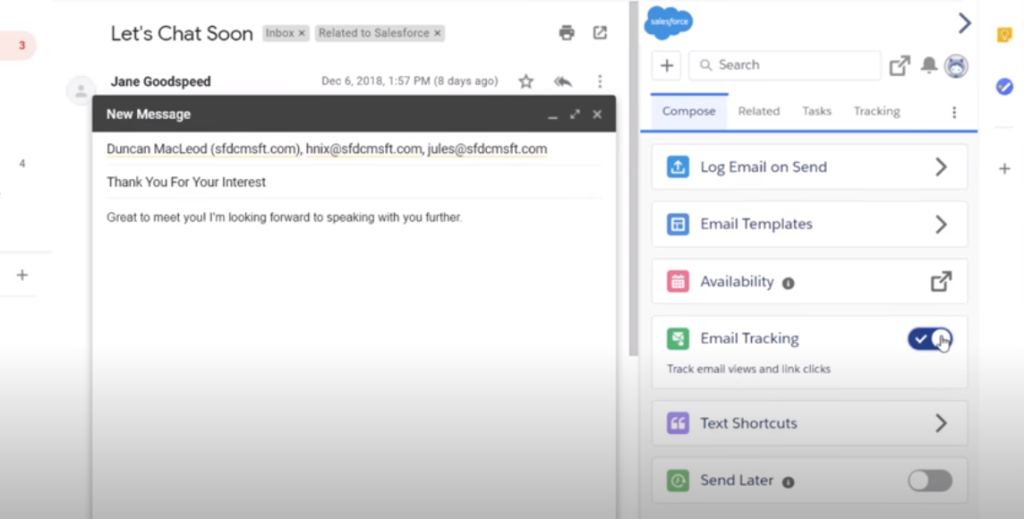
You can write your emails when it’s convenient and have them sent later when they will have the biggest impact.
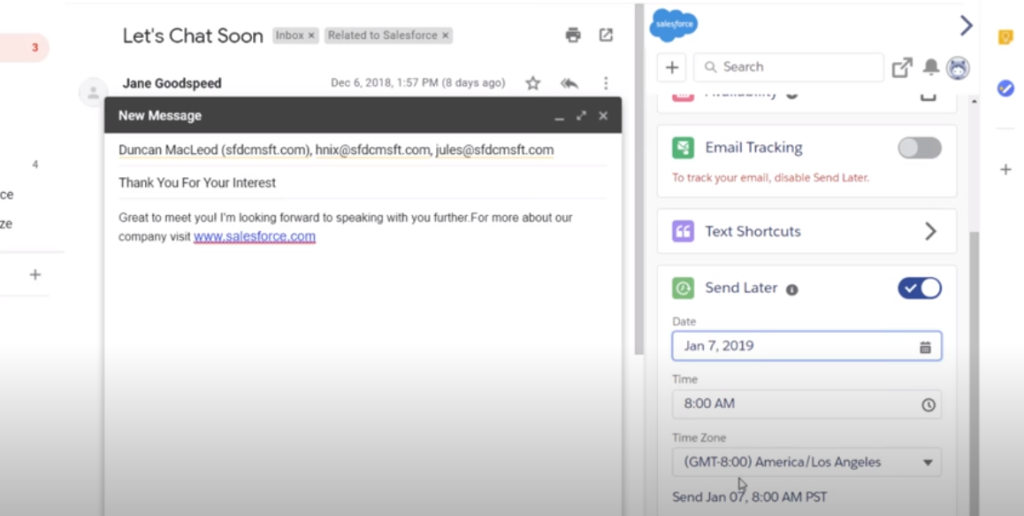
5. Set Availability
Say goodbye to those back and forth emails to schedule meetings. You can set your availability to select open time slots from your calendar and insert them in an email.
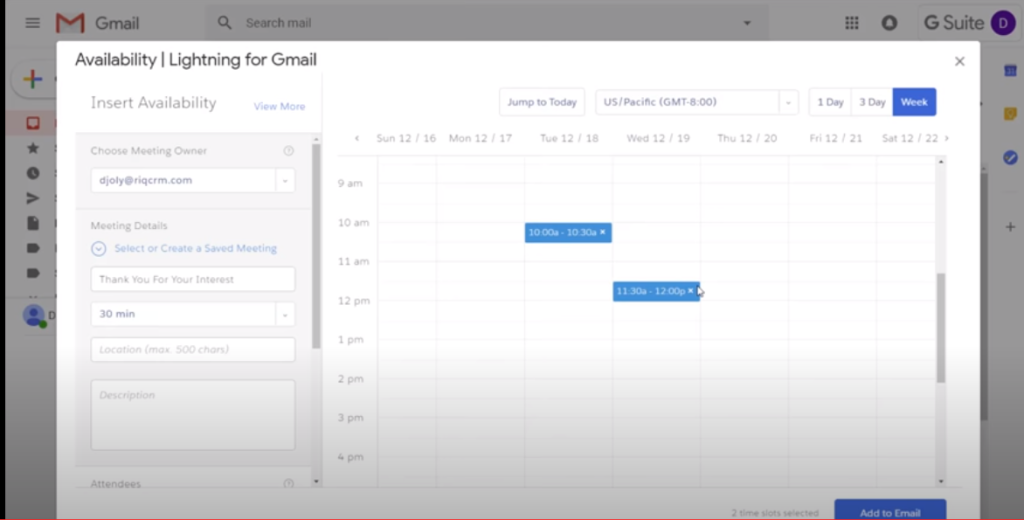
Before You Go
You can now understand how an email integration can help your teams massively by synchronizing tasks, contacts, and accounts to save time and ensure better productivity. The PDFs above will help you achieve the integration successfully. But it’s not just your emails that need integration; it could be your social profiles, accounting software, marketing tools, or any other application. Whichever third-party application, it makes sense to integrate them to the CRM. The data you feed your systems will power returns. It’s just good business sense.
Integrate your external applications with Salesforce and save up to 50% of the time that you spent switching between systems and looking for data on different platforms. You can contact our experts to learn what kind of Salesforce integration can be a fit for your business.
Awards & Accolades






















Got a Question? Ask Us!
Ready to Solidify Your Digital Transformation Efforts Using Salesforce? Talk to Us!

Subscribe to our newsletter
Stay ahead with expert insights, industry trends, and exclusive resources—delivered straight to your inbox.

